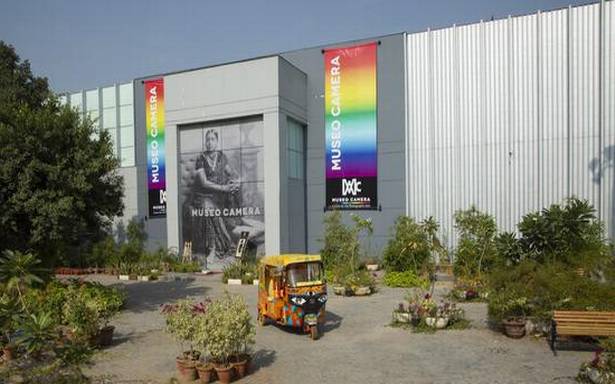Gurugram might be an urban nightmare, but it now has an 18,000 sq.ft. photography museum, India’s first such crowd-funded venture
It’s a rainy August Sunday and people are thronging a popular restaurant down a side road off the posh Golf Course Street in Gurugram. Not unusual for Gurugram, only this restaurant is inside South Asia’s largest not-for-profit photography museum. For those not interested in just food and drink, Museo Camera, Centre for the Photographic Arts, India’s first crowd-funded museum, offers free and paid libraries, lectures, photography exhibitions, unusual objects made from camera parts, kaleidoscopes, impromptu photography sessions and, of course, lessons in contemporary history.
So what’s the need for this huge museum devoted to cameras and photography? How does a camera have any relevance in an age when everyone has a camera on them all the time? The resounding answer to that, of course, comes from the stunning works of Reuters photographer Danish Siddiqui, who was executed earlier this year in Afghanistan.
Photo: Aditya Arya Archive
“At one time a photo was admissible in a court of law as evidence. Now, there is a need to verify it because it could have been manipulated by software,” says Aditya Arya, the advertising man and visual historian who has created this unique 18,000 sq.ft. museum through a public-private partnership with the Municipal Corporation of Gurugram.
It’s an amazing space, with the history of photography displayed on wall text and over 2,500 cameras and other photographic equipment, dating back to the 1850s, on display. The written history makes it clear that countries and genders weren’t discriminated against in photography.
Camera obscura
Greek mathematicians Aristotle and Euclid independently described a camera obscura in the 5th and 4th centuries BCE, and in the 6th century CE, the Byzantine mathematician Anthemius of Tralles used a type of camera obscura in his experiments.
The Arab physicist Ibn al-Haytham (Alhazen) (965-1040 AD) also invented a camera obscura as well as the first true pinhole camera, and this is considered the genesis of the modern camera.
Photo: Aditya Arya Archive
This museum traces the history of photography from the 1830’s to the Digital Era. It was only in the 1830s that the earliest photograph to include people — ‘View of the Boulevard du Temple’, a daguerreotype — was made by Louis Daguerre. By the 1840s, the camera came to India with the earliest known photographs taken during the second Anglo-Sikh War by John McCosh, an army surgeon with the East India Company. The museum has rooms devoted to the use of the camera obscura during the Renaissance, and to pinhole cameras, camera obscura, camera lucida and wet plate cameras. We also see photographic equipment, including the first ever magnesium flash to the magic lantern projector from the 17th century as well as the K20s used during WWII, the 1$ brownie cameras that revolutionised photography, and even Kodak, Yashica, and the camera my father drove back 200 km to buy back from the factory because it took such excellent photos, the Agfa Karat 36.
Photo: Aditya Arya Archive
Iconic images
The collection is actually built from the archives of celebrated photographer Kulwant Roy, who was responsible for many iconic images of the Indian independence movement. Roy left his negatives and archives to Arya, who was both a family friend and Roy’s apprentice from the age of 12. Arya, who went on to become a successful photographer, realised that Roy’s collection, which had remained forgotten in boxes for over 25 years after his death, was priceless. Dating from the 1930s to the 1960s, it made for a rare and valuable visual archive, with many unpublished pictures including Muslim League meetings, INA trials, the signing of the Constitution, as well as significant post-Independence milestones such as the building of Bhakra Nangal Dam.
Photo: Aditya Arya Archive
Talks and exhibitions
Arya himself was an avid collector of cameras and photography-related items from around the world. Soon, he had to rent a couple of basements to store all of it. Then, he entered into a partnership with the Gurugram Municipal Corporation, who gave him an unused badminton court to house the collection.
Arya was there every day to oversee the construction of the museum, working on a shoe-string budget and reading every available book on museum design. He’s got ultraviolet air purifiers, automatic lights, and foot-operated doors. He has digitising, archiving and archival printing services. He does curated walks and holds a stream of exhibitions, on Saibal Das, Waswo X Waswo, Prabir Purkayastha, Randhir Mehra, the lot. Drish Academy, on the premises, holds workshops on everything from photography to salt print and cyanotype.
Photo: Aditya Arya Archive
Unfortunately, almost as soon as Museo Camera was launched, the pandemic hit. Now, the crowds are coming back, albeit to the restaurant — a fact that Arya has to make his peace with.
“What does a museum contribute,” he muses. “It increases liveability. Children can learn and spend time here. Every municipality and government should mandatorily create such spaces and individuals and small organisations need to get involved. It’s not that hard”.
Gurugram has 1.2 million people and five museums. I see two young girls enjoying a kaleidoscope placed in the lobby as they wait for a table in the restaurant; later, I see two other girls discuss freedom and photos with Arya in the exhibition area. Baby steps…
The writer is the author of a fantasy series, and specialises in art and culture of South East Asia.
Source: Read Full Article


